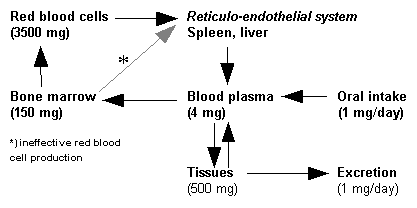What is hereditary hemochromatosis? What causes it?
Hereditary hemochromatosis is a health problem that is passed from parents to children. It is inherited by passing on the HFE gene. The HFE gene makes your body store too much iron. The extra iron builds up in your body. This is called "iron overload." Iron overload can damage tissues and organs.
Does anything else cause iron overload?
Yes, you could have iron overload that isn't caused by a hereditary problem. Iron overload can show up in people who have been taking iron pills for more than 10 years. People who have to get many blood transfusions might end up with iron overload. In addition, people with certain kinds of anemia or liver disease may also have iron overload.
What are some signs of hereditary hemochromatosis?
Most people with hereditary hemochromatosis show no signs of the illness until they are middle-aged. They might have only mild signs, like tiredness, or they might have arthritis or impotence. These signs can also be caused by something else. They might not mean that you have hereditary hemochromatosis.
The signs of hereditary hemochromatosis are different from person to person. Men are more likely to have signs than women. The signs you have depend on the amount of iron in your diet or if you are taking iron pills or drinking alcohol. Blood loss in menstruation and pregnancy can also be factors.
People who have a very high iron level may have skin with a bronze or gray color. Their liver may get bigger. Their lab tests may be abnormal. The liver may become scarred. They might get cirrhosis--permanent and extensive scarring in the liver. Other signs of hereditary hemochromatosis include diabetes, a weak heart, and problems with glands or joints.
How does my doctor find out if I have hereditary hemochromatosis?
Your doctor will ask you about certain signs, do a physical exam and look at the results of your blood tests. If your blood tests are not normal, your doctor might do a test to look for an HFE gene.
If you have signs of hereditary hemochromatosis, you might need to have a liver biopsy to see if your liver is damaged. For the biopsy, a small piece is taken from your liver and looked at under a microscope. If you have cirrhosis, you have a high risk for getting liver cancer. A few people need to have a liver transplant.
How is hereditary hemochromatosis treated?
You will probably have phlebotomy (say this: flee-bot-oh-me). This word means removal of blood. A pint of blood is taken out of your body once a week. It's just like donating blood.
It may take a few months to a few years of weekly phlebotomy to get the extra iron out of your body. Then you will have phlebotomy about four times a year to keep the iron from building up again. The goal of the treatment is to keep a normal level of iron in your blood.
If you have hereditary hemochromatosis, you can do some things to help:
* Don't take iron supplements, not even vitamins with iron in them.
* Don't eat very much red meat.
* Don't drink very much alcohol. You might give up all alcohol. Too much iron plus alcohol can make liver disease worse. Ask your doctor if you can drink alcohol and how much is OK for you to drink.
* Don't eat raw shellfish. Don't even touch raw shellfish, because you have an increased risk of bacterial infection.
What is the outlook for people with hereditary hemochromatosis?
With early diagnosis and treatment, nearly all the problems of hereditary hemochromatosis can be prevented. If the illness is diagnosed and treated before you get cirrhosis or diabetes, your life expectancy should be normal.
Who should be tested for hereditary hemochromatosis?
Everyone with a relative with hereditary hemochromatosis should have blood tests to see if they also have it. All people with medical conditions that could be caused by hereditary hemochromatosis should be checked for iron overload. Even if your lab results are normal, you might need to get blood tests again every few years if you have some of the signs of hereditary hemochromatosis or a relative with it.
Adult relatives of a person with hereditary hemochromatosis might consider having a special test to look for an abnormal HFE gene. This test would tell their doctor if they might also have hereditary hemochromatosis.
Your doctor should explain to you the benefits and risks of genetic testing, because you could have problems with your job or getting insurance if you have the HFE gene. That is why HFE gene testing usually is not recommended for children younger than 18 years of age.
COPYRIGHT 2002 American Academy of Family Physicians
COPYRIGHT 2002 Gale Group



